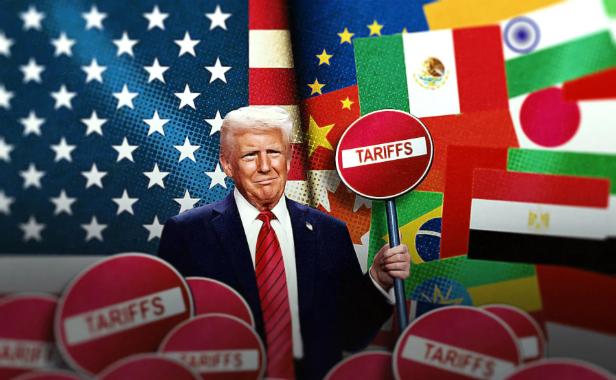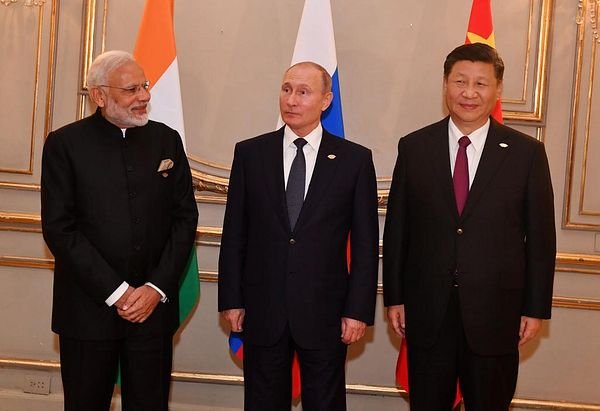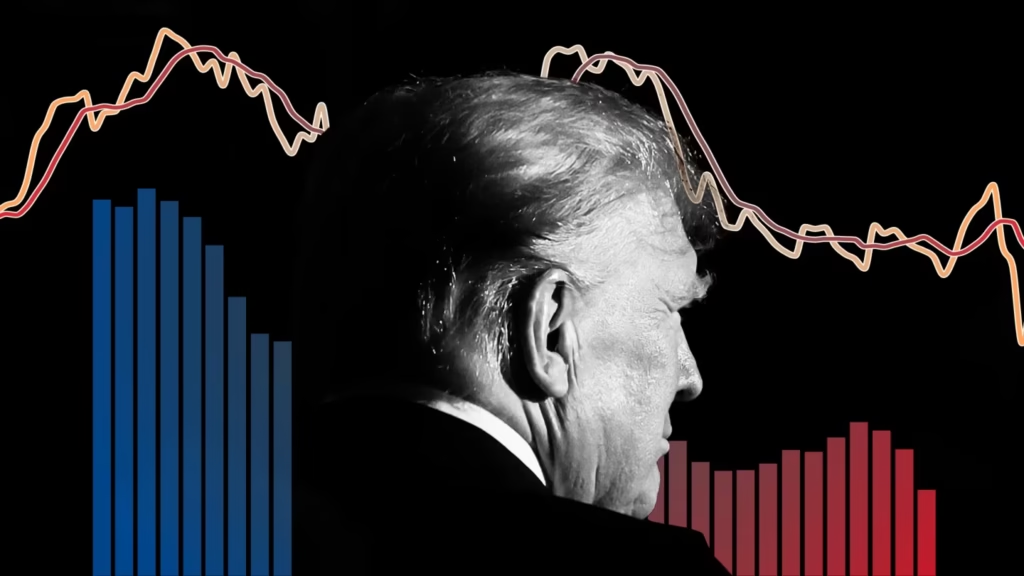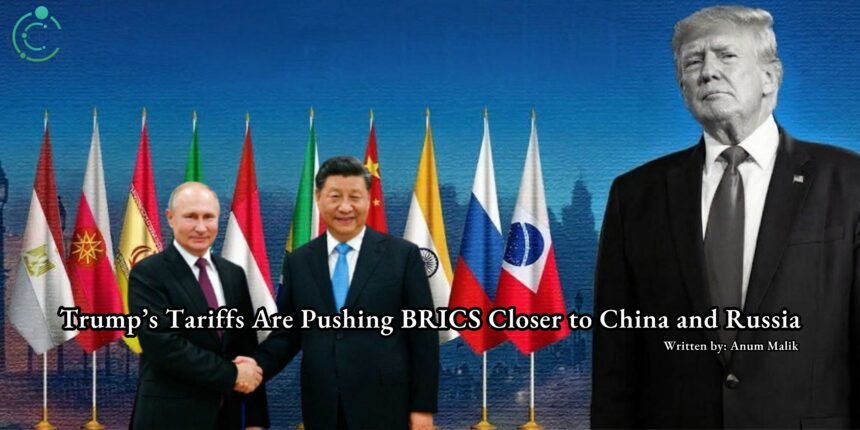Trump’s Tariff War and BRICS
President Donald Trump has never been shy about using tariffs as a political tool. His recent move to impose heavy duties on India, Brazil, and South Africa three founding members of BRICS looks, at first sight, like an economic decision. But in reality, this step is shaping global politics in unexpected ways. By targeting these countries, Trump has unintentionally pushed them closer toward China and Russia. While this may not have been his original aim, it has become the natural outcome of his policy.
- Trump’s Tariff War and BRICS
- Changing Perceptions about the United States
- Russia & India: A Shared Difficult Realization
- The Rise of ‘De-dollarization’
- A New Global Balance of Power
- Conclusion
- The author Anum Malik, is affiliated with the State News Agency and contributes her research to the think tank, CDS.
- *The views and opinions expressed herein, and any references, are those of the author and do not necessarily reflect the editorial policy of the Centre for Development and Stability (CDS).
For years, BRICS (Brazil, Russia, India, China, and South Africa) was often seen as a loose grouping without much internal unity. Each member had its own distinct priorities. China and Russia usually cooperated on matters of security and geopolitics, Brazil and South Africa focused more on development and financing, while India tried to balance carefully between the US and China. This meant that while BRICS had symbolic importance in the Global South, it rarely spoke with one united voice.
But Trump’s tariff war has changed the dynamics. By hitting three BRICS members simultaneously, he has created a shared sense of “economic victimhood.” This, in turn, is giving BRICS a new reason to close ranks and explore deeper cooperation.
Changing Perceptions about the United States

The most important effect of these tariffs is psychological. For many years, despite differences, developing countries still saw the United States as a global leader that, at least sometimes, provided stability and public goods. Washington was seen as powerful, but also as a partner that could show generosity in trade or investment.
Trump’s aggressive measures, however, have broken this perception. His tariffs were overtly punitive, leaving almost no space for negotiation. They were designed to punish, not to bargain. For example:
- Against India, Trump doubled tariffs to 50% on textiles, electronics, gemstones, and auto parts, citing its purchase of Russian oil.
- Against Brazil, he raised tariffs from 10% to 50%, claiming retaliation by President Lula’s government against Jair Bolsonaro, who was Trump’s political ally.
- Against South Africa, he raised tariffs to 31%, citing “persecution of white citizens” as a justification.
Each of these cases shows that Trump used political reasoning, not purely economic logic. For the affected countries, this revealed the US as a nakedly transactional power one that places its own interest above all else. Once trust in a global leader is broken, it is extremely difficult to restore. This is not only a matter of psychology, but it directly affects long-term planning and policy.
Russia & India: A Shared Difficult Realization
Among all the countries hit by tariffs, India’s case is the most significant. For years, New Delhi followed a policy of “strategic autonomy”. It built strong ties with Washington on security and technology, positioning itself as a key partner in the US Indo-Pacific strategy. At the same time, it kept close relations with Moscow for energy and defence, while engaging China in multilateral forums like BRICS and the Shanghai Cooperation Organization (SCO).
This balancing act allowed India to gain technology and investment from the US, while maintaining critical ties with Russia and limited cooperation with China.
Trump’s tariffs, however, have been a shock for India. For the first time, it realised that being part of the US Indo-Pacific strategy does not protect it when American economic interests are at stake. The 50% tariff has disrupted Indian exports and triggered a debate among policymakers and analysts in New Delhi: Can India really rely on the US for its long-term interests?

This does not mean India will suddenly align with China. The border disputes, regional rivalries, and competitive instincts between the two remain very strong. But it does mean India may reduce its obstructionist role inside BRICS and SCO. Instead of openly siding with Washington’s positions, India could become more cooperative with China on non-core issues. Even small adjustments in this direction could allow BRICS to function more smoothly and take collective steps with greater efficiency.
Signs of this shift are already visible. Prime Minister Narendra Modi’s planned visit to China, his first in seven years, and India’s decision to suspend US arms purchases both suggest that New Delhi is carefully rethinking its reliance on Washington.
The Rise of ‘De-dollarization’
Another major consequence of Trump’s tariff war is the renewed push for “de-dollarization”. For decades, the US dollar has been the backbone of global trade and finance. This position gives Washington immense power. It can impose tariffs and sanctions without worrying about a loss of currency credibility, while other countries face the risk of depreciation, capital flight, and financial instability.
For BRICS, this imbalance has long been a concern. Discussions about trading in local currencies, creating alternatives to SWIFT, and expanding the BRICS Bank have been ongoing, but progress has been slow. Now, with Trump’s tariffs reminding countries of their vulnerability, these ideas are gaining real momentum.
Brazil has already pledged to work with India and China to resist US tariff threats collectively. South Africa has spoken about financial reforms, and Russia has long been advocating for alternatives to the dollar. If India also becomes more open to these proposals, BRICS could take concrete steps toward building a financial system that reduces dependence on the US dollar.
A New Global Balance of Power

Beyond economics, the bigger picture is about the future of global politics. The United States itself is becoming more unpredictable. Even if Trump does not return to office, both the Republican and Democratic parties have adopted more protectionist and inward-looking policies. This means that countries can no longer assume stable economic engagement with the US.
For nations in the Global South, including India, Brazil, and South Africa, the old formula, “do business with America while balancing politically with China and Russia” is becoming less reliable. A new formula is emerging: “diversify risks while protecting against sudden reversals in US policy.”
This shift opens the door for China and Russia to play a stronger leadership role within BRICS. If the group can institutionalize its decision-making moving beyond summit declarations and informal talks, it could transform into a serious geopolitical player. History shows that external threats often strengthen internal unity. Just as NATO became stronger during the Cold War under the Soviet threat, BRICS could become more coherent under US tariffs and financial pressure.
Conclusion
In conclusion, Trump’s tariff war may look like a direct economic strike against a few countries’ exports, but its real consequences go much deeper. It is:
- Breaking trust in the United States.
- Forcing India to rethink its heavy reliance on Washington.
- Giving momentum to de-dollarization.
- Strengthening BRICS unity under Chinese and Russian leadership.
For China, this is a golden opportunity to present itself as the stable and reliable leader of the Global South. For BRICS as a whole, it is both a challenge and a historic chance. If the group can transform unity born out of external pressure into long-term institutional strength, it may reshape the global order into a more multipolar system, one less dominated by the US.
Seen from this angle, Trump’s tariffs are more than a trade war. They are a turning point that could push BRICS onto a path of greater influence in world politics, changing the balance of power in the years to come.



